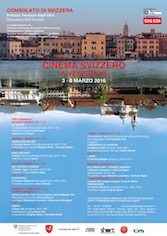
Swiss Cinema in Venice (2012 - 2016)
For its fifth anniversary the event devoted to Swiss cinema presents an unusually rich line-up: along six days the audience will attend the screenings of films - many of them never seen in Italy before - and will meet renowned guests: the veterans Lionel Baier, Samir and Stefan Jäger and the newcomers Esen Isik, Antonio Bigini and Mariann Lewinsky to name a few. And the maestro of the European cinema, Fredi M. Murer, will introduce the screening of the restored version of his masterpiece, Höhenfeuer.Moreover, Carlo Montanaro and La Fabbrica del Vedere helped in organizing an animation workshop that will avail itself of the services of experienced tutors, led by Nicolas Burlet, co-founder of Nadasdy Film, the most renowned animation production company in Switzerland.
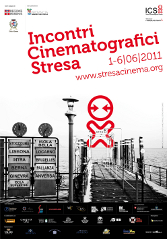
Incontri Cinematografici di Stresa (2006 - 2011)
Founded in 2006, the Incontri Cinematografici di Stresa was an international film event, whose object was a dynamic comparison between Italian and European cinema. In 2009, after three editions exclusively focused on Italy and Switzerland, the festival opened up to other European nations (starting from French-speaking Belgium). This process of gradual enlargement continued in the fifth and sixth edition, whose programme selection included Portugal, Flemish-speaking Belgium and Sweden.The seven-day programme featured screenings, premieres, retrospectives, special events and public meetings. The programme also included more spectacular events – such as readings, concerts, and the festival’s “happy hours”, with live music – scattered round the city centre, in the most charming spots of Stresa, so as to turn the whole city into a festival venue.
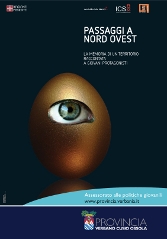
Northwest Passages (2009 - 2010)
Northwest Passages is targeted to young people with the aim of combining entertainment with education through a series of screenings, meetings with authors and reviewers and thematic parties. It focuses on the analysis of the social dynamics which affected North Italian major cities during the tumultuous 1970s, offering an unconventional view of the Milan and Turin areas through the lenses of the Italian popular genres (poliziottesco, noir, horror).It is also a survey on the most vital season of the Italian cinema, which was able to reflect the moods and fears of a post-1968 strife-torn country.
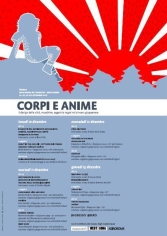
Body and Anima (2007)
Body and Anima is the meeting point between cinema world and Japanese architecture, in the form of working plans and constructions of (real, possible and conceived) spaces and cities, signs and objects. The event presented a series of panels and screenings where film, architecture and art authorities, along with renown historians, have analyzed forms and ideas of contemporary architecture and visual design applications in the Land of the Rising Sun, with a peculiar view to the most used and popular media.Composed either of BODIES (real actors) or ANIME (cartoons), the screened movies – unreleased, nearly unknown or to be discovered – stand out for their high visual impact and the strong influence on the collective Western imagination.
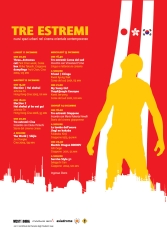
Three Extremes (2006)
New urban spaces in contemporary cinema
Three Extremes is "pure cinema", a priviliged witness of contemporaneity, and also the means by which every transformation is captured. Not the mere representation of an urban space, it is the mirror of the evolution in human relations, in everyday life and in common imaginary, within that same "moving" space. Three Extremes intended to present an analysis of the strong links between cinema and urban spaces, social and economic changes, new cinema languages and new, memorable (anti-)heros.Three Extremes threw a look to a cinema territory - the asiatic one - that is more and more visible in the international context, though yet to be fully discovered.
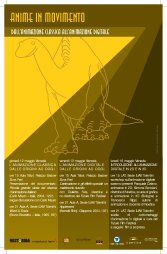
Moving Souls (2005)
Ever since the dawn of the silver screen, animated cinema has been viewed as an experimental field of artistic research. Not older than twenty, digital animation has deeply changed the cartoon cinema - becoming a partner, or rather part, of classical animation - though in ways not always fully recognizable.This project wanted to cast a look on this ever-moving area, on the one hand offering a survey of both classical and digital animation, on the other proposing a first technical and professional approach to the digital world. This is why "theorists" have been placed side by side with those professionals who deal with the practice and the teaching of digital techniques in everyday life. It was structured to be a practical way to let audience know about one of the most common - though less known - aspects of contemporary cinema.
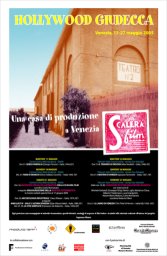
Hollywood Giudecca (2005)
Scalera Film was founded in Rome in 1938 on the initiative of Scalera brothers, who had been building contractors closely knit to the fascist regime. It soon became the major Italian motion picture company. Scalera's studios in Venice opened on May 6th, 1944 and continued their activity until the mid-1950s. Scalera's production system, even if certainly minor, was nevertheless vital and remarkable.As Venice and Giudecca islands are currently undergoing relevant changes, it seemed the right moment to analyze some features of a little known history and of an unique production industry, giving voice to historians, authorities and particularly to those who witnessed those events. Hollywood Giudecca then wanted to be an occasion to study the peculiarities of the "Scalera system", but also a fond tribute to the Giudecca island and its residents.

Tribute to Peter Jackson (2004)
On the occasion of the release of the last - eagerly awaited - episode of The Lord of The Rings trilogy, "Multisala ESU" presented to students and cinephiles a tribute to director Peter Jackson, screening all the movies this creative New Zealand cineaste directed from the beginning of his career in 1987 to the dawn of the trilogy that made him a name all over the world.Not only did the event rediscover "forgotten" classics such as The Frighteners, Heavenly Creatures and Forgotten Silver, the remarkable "mockumentary" on the origins of cinema, but it made audience also enjoy the director's splatter productions: Bad Taste, Braindead and particularly Meet the Feebles, the latter unreleased in Italy.
Associazione Modulo Lem: Via Ro 4 - 44030 Ro Ferrarese (FE)
info@modulolem.it
info@modulolem.it
